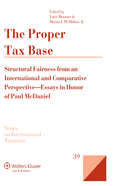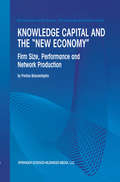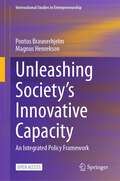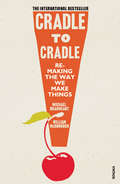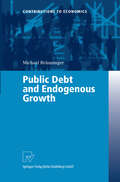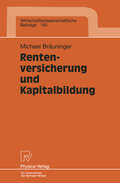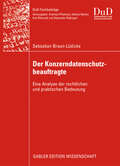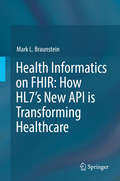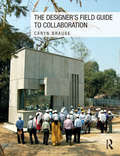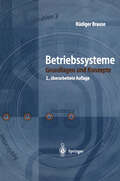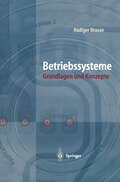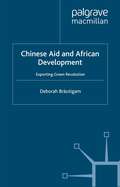- Table View
- List View
The Proper Tax Base: Structural Fairness from an International and Comparative Perspective - Essays in Honour of Paul McDaniel (Series on International Taxation #39)
by Yariv Brauner Martin James McMahonVirtually all objections to taxation schemes spring from perceptions of unfairness. Is tax fairness possible? The question is certainly worth investigating in depth, and that is the purpose of this book. Today, as governments are busily making new tax rules in the wake of staggering budget deficits, is perhaps an appropriate time to pay heed to fairness so it can be incorporated as far as possible into tax reform. With twelve contributions from some of the world’s most respected international tax experts—including the late Paul McDaniel, in whose honor these essays were assembled—this invaluable book focuses on tax expenditure analysis, the quest for a just income tax, and division and/or harmonization of the income tax base among jurisdictions. Among the areas of taxation ripe for reform from a fairness point of view the authors single out the following: tax expenditure budget construction; tax expenditure reporting; modern welfare economics as a driver of tax reform; grantor trust rules; the notion of “horizontal equity”; the international tax norm of “income source”; transfer pricing; and jurisdictional application of VAT. Specific ongoing reforms in the United States, Australia, and other countries—as well a detailed analysis of the EU’s proposed common consolidated corporate tax base (CCCTB)—are also examined for fairness. As a timely, high-quality resource that effectively tackles an array of salient issues, this is a book that will be read and studied by tax practitioners, corporate tax experts, government tax policy makers, advisers and consultants on the reform and design of tax systems, and international organizations involved in standard setting related to tax administration, as well as academics and researchers.
Knowledge Capital and the “New Economy”: Firm Size, Performance And Network Production (Economics of Science, Technology and Innovation #20)
by Pontus BraunerhjelmAccording to its proponents, the `new economy' is associated with sustainable growth, increased demand for labor and zero inflation. On the micro-level, this bright avenue into the future is propelled by knowledge capital, flexibility and new ways of organizing production, such as clusters and networks. Progress in information technology, together with massive deregulation on the national and the international levels, have been credited with setting this development into motion. The concept of the `new economy' has been rapidly embraced by politicians, as it seems to offer a way out of the traditional trade-off between unemployment and wage inflation. However, empirical evidence regarding the microeconomic mechanisms of the `new economy' is scarce. Knowledge Capital and the `New Economy': Firm Size, Performance and Network Production intends to narrow this gap by empirically analyzing the composition of knowledge capital and how knowledge capital is distributed across firms of different size. Moreover, the impact of knowledge capital on firms' profitability and international competitiveness is also examined. Finally, we compare cluster dynamics and the institutional set-up in Europe and the U.S., with the purpose of identifying regulations that seem to hinder a conducive environment for expanding and dynamic European clusters. The results of this study emphasize the role of knowledge capital and flexibility. Thus, irrespective of how sustainable the `new economy' turns out to be, the policy implications in terms of providing institutions that facilitate knowledge-enhancing economic activities, flexible markets and transparent incentive structures are undeniable. Countries that fail in this respect may find themselves trailing in the international growth and welfare rankings.
Unleashing Society’s Innovative Capacity: An Integrated Policy Framework (International Studies in Entrepreneurship #55)
by Pontus Braunerhjelm Magnus HenreksonThis is an open access book. Europe faces significant challenges in the coming decades: geopolitical, demographic, technological, increased competition, climate-related, and health issues due to an aging population, to mention a few. Given these challenges, technological progress and new ways of handling complex issues will be key to continued prosperity and growth. To accomplish a growth process driven by innovation and entrepreneurship, the institutional environment must take into account a multitude of different policy areas that interact to either strengthen or weaken an economy's innovative potential. Innovation is not only about R&D and higher education but is also intimately related to entrepreneurship. Similarly, entrepreneurship is not only about low start-up costs and favorable tax rates. Hence, a consistent and coordinated policy environment conducive to innovation and entrepreneurship is required to translate innovation into high-growth firms and macro-level growth. This book presents the basic cornerstones required to provide a policy regime that can nurture such dynamics. The authors draw extensively on empirical analysis of the development of the Swedish economy, which has been transformed from a so-called "sclerosis" state in the 1980s until the early 1990s to an economy characterized by successful entrepreneurship and innovation. This transformation resulted from a reform agenda that has been gradually rolled out, beginning in the mid-1980s. The authors argue that the Swedish experience provides useful lessons for other nations as well.
Cradle to Cradle: (Patterns of the Planet) (Patterns Of Life Ser.)
by Michael Braungart William McDonoughRecycling is good, isn’t it? In this visionary book, chemist Michael Braungart and architect William McDonough challenge this status quo and put forward a manifesto for an intriguing and radically different philosophy of environmentalism."Reduce, reuse, recycle”. This is the standard “cradle to grave” manufacturing model dating back to the Industrial Revolution that we still follow today. In this thought-provoking read, the authors propose that instead of minimising waste, we should be striving to create value. This is the essence of Cradle to Cradle: waste need not to exist at all. By providing a framework of redesign of everything from carpets to corporate campuses, McDonough and Braungart make a revolutionary yet viable case for change and for remaking the way we make things.
Public Debt and Endogenous Growth (Contributions to Economics)
by Michael BräuningerThis book considers public debt dynamics in various endogenous growth mod els, namely the AK model and explicit models of innovation and human cap ital accumulation. Furthermore, the closed economy, the small open economy and a two-country world are analysed. In the closed economy model, the focus is on budget deficit and public debt dynamics and their influence on capital growth and output growth. Then, in the open economy model, the effects on foreign debt growth are considered. In a two-country setting, public debt growth in one country affects growth in the other country. In each scenario the government either fixes the deficit ratio or the tax rate. For both strategies the steady state is derived and stability is analysed. Then, dynamics induced by various shocks and policy measures are explored. Many diagrams illustrate the dynamics. I greatly benefited from comments by Michael Carlberg. In addition, Alkis Otto and Justus Haucap discussed with me many parts of the book. I wish to thank them all. Hamburg, February 2003 Michael Briiuninger Contents 1 Introduction. . . . . . . . . . . . . . . . . . . . . . . . . . . . . . . . . 1 . . . . . . . . . . . . . . Part I The Closed Economy with AK Production 2 The Solow Model. . . . . . . . . . . . . . . . . . . . . . . . . . . . . . . . 5 . . . . . . . . . . 2. 1 Introduction. . . . . . . . . . . . . . . . . . . . . . . . . . . . . . . . . . . . . . . . . . . . 5 2. 2 Fixing the Deficit Ratio. . . . . . . . . . . . . . . . . . . . . . . . . . 6 . . . . . . . . 2. 2. 1 The Model. . . . . . . . . . . . . . . . . . . . . . . . . . . . . . 6 . . . . . . . . . 2. 2. 2 Stability. . . . . . . . . . . . . . . . . . . . . . . . . . . . . . . . . . . . . . . . . 12 2. 2. 3 Some Shocks. . . . . . . . . . . . . . . . . . . . . . . . . . . . . 12 . . . . . . . . . 2. 2. 4 Summary. . . . . . . . . . . . . . . . . . . . . . . . . . . . . . . . . . . . . . . . . 18 2. 3 Fixing the Tax Rate. . . . . . . . . . . . . . . . . . . . . . . . . . . . 18 . . . . . . . . . 2. 3. 1 The Model . . . . . . . . . . . . . . . . . . . . . . . . . . . . . . . . . . . . . . . 18 2. 3. 2 Stability. . . . . . . . . . . . . . . . . . . . . . . . . . . . . . . . . . . . . . . . . 21 2. 3. 3 Some Shocks. . . . . . . . . . . . . . . . . . . . . . . . . . . . . 22 . . . . . . . . . 2. 3. 4 Summary. . . . . . . . . . . . . . . . . . . . . . . . . . . . . . . . . . . . . . . . .
Rentenversicherung und Kapitalbildung (Wirtschaftswissenschaftliche Beiträge #160)
by Michael BräuningerDer Konzerndatenschutzbeauftragte: Eine Analyse der rechtlichen und praktischen Bedeutung (DuD-Fachbeiträge)
by Sebastian Braun-LüdickeSebastian Braun-Lüdicke untersucht die Umsetzbarkeit einer gesetzlichen Regelung des Konzerndatenschutzbeauftragten in einem rechtstheoretischen, einem rechtspraktischen und einem empirischen Teil. Er zeigt die rechtlichen und praktischen Probleme der fehlenden Rechtsgrundlage auf und entwickelt einen Lösungsansatz in Form eines Normierungsvorschlags.
Die Kreditgeldwirtschaft: Hintergründe und Irrtümer von Geld- und Finanzwirtschaft
by Christoph Braunschweig Bernhard PichlerDas Buch stellt auf leicht verständliche und anschauliche Weise Irrtümer im Bereich der Geldtheorien dar und erläutert die fatalen Folgen geldtheoretischer Fehleinschätzungen und ordnungspolitischer Verstöße für Wirtschaft und Gesellschaft. Orientiert an der Konjunkturtheorie Friedrich A. von Hayeks erhält der Leser einen ebenso kompakten wie fundierten Überblick über das vielschichtige Thema Geld. Dabei werden aktuelle wirtschaftspolitische Themen aufgegriffen: Führt die Kreditwirtschaft zur Geldschwemme? Warum scheitert die „Mainstream-Ökonomie“? Was sind die tatsächlichen Ursachen von Finanzkrisen und welche Lösungsmöglichkeiten gibt es? Kritisch und informativ arbeiten die Autoren aktuelle Fragen wie diese auf und analysieren auf der Basis klassisch-liberaler volkswirtschaftlicher Theorien die Konsequenzen hinsichtlich Staatsschulden, Geldschöpfung, Geldmenge, Zinsen, Inflation, Eurokrise, Wettbewerbsfähigkeit, Arbeitslosigkeit und Wachstum.
Die Kreditgeldwirtschaft: Hintergründe und Irrtümer von Geld- und Finanzwirtschaft
by Christoph Braunschweig Bernhard PichlerDas Buch stellt auf leicht verständliche und anschauliche Weise Irrtümer im Bereich der Geldtheorien dar und erläutert die fatalen Folgen geldtheoretischer Fehleinschätzungen und ordnungspolitischer Verstöße für Wirtschaft und Gesellschaft. Orientiert an der Konjunkturtheorie Friedrich A. von Hayeks erhält der Leser einen ebenso kompakten wie fundierten Überblick über das vielschichtige Thema Geld. Dabei werden aktuelle wirtschaftspolitische Themen aufgegriffen: Führt die Kreditwirtschaft zur Geldschwemme? Warum scheitert die „Mainstream-Ökonomie“? Was sind die tatsächlichen Ursachen von Finanzkrisen und welche Lösungsmöglichkeiten gibt es? Kritisch und informativ arbeiten die Autoren aktuelle Fragen wie diese auf und analysieren auf der Basis klassisch-liberaler volkswirtschaftlicher Theorien die Konsequenzen hinsichtlich Staatsschulden, Geldschöpfung, Geldmenge, Zinsen, Inflation, Eurokrise, Wettbewerbsfähigkeit, Arbeitslosigkeit und Wachstum.
Einstellungsforschung und Kundenbindung: Zur Erklärung des Treueverhaltens von Konsumenten
by Christine BraunsteinChristine Braunstein analysiert Erkenntnisse der neueren Einstellungs- und Willensforschung im Hinblick auf Kundenbindung, -loyalität und -zufriedenheit und entwirft ein Kundenbindungsmodell.
Capital Choices: Sectoral Politics and the Variation of Sovereign Wealth
by Juergen BraunsteinSovereign wealth funds are state-controlled pools of capital that hold financial and real assets, including shares of state enterprises, and manage them to grow the nation’s base of sovereign wealth. The dramatic rise of sovereign wealth funds (SWFs) in both number and size—this group is now larger than the size of global private equity and hedge funds, combined—and the fact that most are located in non-OECD countries, has raised concern about the direction of capitalism. Yet SWFs are not a homogenous group of actors. Why do some countries with large current account surpluses, notably China, create SWFs while others, such as Switzerland and Germany, do not? Why do other countries with no macroeconomic justification, such as Senegal and Turkey, create SWFs? And why do countries with similar macroeconomic features, such as Kuwait and Qatar or Singapore and Hong Kong, choose different types of SWFs? Capital Choices analyzes the creation of different SWFs from a comparative political economy perspective, arguing that different state-society structures at the sectoral level are the drivers for SWF variation. Juergen Braunstein focuses on the early formation period of SWFs, a critical but little understood area given the high levels of political sensitivity and lack of transparency that surround SWF creation. Braunstein’s novel analytical framework provides practical lessons for the business and finance organizations and policymakers of countries that have created, or are planning to create, SWFs.
Capital Choices: Sectoral Politics and the Variation of Sovereign Wealth
by Juergen BraunsteinSovereign wealth funds are state-controlled pools of capital that hold financial and real assets, including shares of state enterprises, and manage them to grow the nation’s base of sovereign wealth. The dramatic rise of sovereign wealth funds (SWFs) in both number and size—this group is now larger than the size of global private equity and hedge funds, combined—and the fact that most are located in non-OECD countries, has raised concern about the direction of capitalism. Yet SWFs are not a homogenous group of actors. Why do some countries with large current account surpluses, notably China, create SWFs while others, such as Switzerland and Germany, do not? Why do other countries with no macroeconomic justification, such as Senegal and Turkey, create SWFs? And why do countries with similar macroeconomic features, such as Kuwait and Qatar or Singapore and Hong Kong, choose different types of SWFs? Capital Choices analyzes the creation of different SWFs from a comparative political economy perspective, arguing that different state-society structures at the sectoral level are the drivers for SWF variation. Juergen Braunstein focuses on the early formation period of SWFs, a critical but little understood area given the high levels of political sensitivity and lack of transparency that surround SWF creation. Braunstein’s novel analytical framework provides practical lessons for the business and finance organizations and policymakers of countries that have created, or are planning to create, SWFs.
Health Informatics in the Cloud (SpringerBriefs in Computer Science)
by Mark L. BraunsteinDespite its high cost, the US healthcare system produces relatively short life spans, and is wasteful, inefficient and has serious safety and quality issues. While other industries have surmounted similar challenges by transforming themselves through information technology, healthcare lags behind. Major reasons are that our approaches to care delivery and financial incentives were designed for a bygone era. Beyond that the technology offered to practitioners has often been overly expensive, poorly designed, overly proprietary, hard to implement and difficult to use. Spurred by a unique, one-time Federal stimulus and the new mobile, wireless and cloud technologies now available, this landscape is rapidly changing. To succeed going forward practitioners, and those interested in entering the field, need to understand the new driving forces and have a basic understanding of contemporary clinical informatics. Practitioners, in particular, need to understand the alternative technologies and approaches available for their use in individual patient care and more continuous management of their chronic disease patients. To efficiently meet these needs, this book provides an introduction to the rationale for care transformation through clinical informatics; its application to patient care outside of hospitals; and a look at its future. Key points are illustrated throughout by actual examples of open source and commercial health IT products and services. While written with practitioners and students entering the field of clinical informatics in mind, the book eschews technical terminology and is easily accessible by the lay reader not proficient in clinical medicine or information technology.
Health Informatics on FHIR: How HL7's New API is Transforming Healthcare
by Mark L. BraunsteinThis textbook begins with an introduction to the US healthcare delivery system, its many systemic challenges and the prior efforts to develop and deploy informatics tools to help overcome those problems. It goes on to discuss health informatics from an historical perspective, its current state and its likely future state now that electronic health record systems are widely deployed, the HL7 Fast Healthcare Interoperability standard is being rapidly accepted as the means to access the data stored in those systems and analytics is increasing being used to gain new knowledge from that aggregated clinical data. It then turns to some of the important and evolving areas of informatics including population and public health, mHealth and big data and analytics. Use cases and case studies are used in all of these discussions to help readers connect the technologies to real world challenges. Effective use of informatics systems and tools by providers and their patients is key to improving the quality, safety and cost of healthcare. With health records now digital, no effective means has existed for sharing them with patients, among the multiple providers who may care for them and for important secondary uses such as public/population health and research. This problem is a topic of congressional discussion and is addressed by the 21st Century Cures Act of 2016 that mandates that electronic health record (EHR) systems offer a patient-facing API. HL7’s Fast Healthcare Interoperability Resources (FHIR) is that API and this is the first comprehensive treatment of the technology and the many ways it is already being used. FHIR is based on web technologies and is thus a far more facile, easy to implement approach that is rapidly gaining acceptance. It is also the basis for a ‘universal health app platform’ that literally has the potential to foster innovation around the data in patient records similar to the app ecosystems smartphones created around the data they store. FHIR app stores have already been opened by Epic and Cerner, the two largest enterprise EHR vendors. Provider facing apps are already being explored to improve EHR usability and support personalized medicine. Medicare and the Veteran’s Administration have announced FHIR app platforms for their patients. Apple’s new IOS 11.3 features the ability for consumers to aggregate their health records on their iPhone using FHIR. Health insurance companies are exploring applications of FHIR to improve service and communication with their providers and patients. SureScripts, the national e-Prescribing network, is using FHIR to help doctors know if their patients are complying with prescriptions. This textbook is for introductory health informatics courses for computer science and health sciences students (e.g. doctors, nurses, PhDs), the current health informatics community, IT professionals interested in learning about the field and practicing healthcare providers. Though this textbook covers an important new technology, it is accessible to non-technical readers including healthcare providers, their patients or anyone interested in the use of healthcare data for improved care, public/population health or research.
Practitioner's Guide to Health Informatics
by Mark L. Braunstein"This book will be a terrific introduction to the field of clinical IT and clinical informatics" -- Kevin Johnson"Dr. Braunstein has done a wonderful job of exploring a number of key trends in technology in the context of the transformations that are occurring in our health care system" -- Bob Greenes"This insightful book is a perfect primer for technologists entering the health tech field." -- Deb Estrin"This book should be read by everyone." -- David KibbeThis book provides care providers and other non-technical readers with a broad, practical overview of the changing US healthcare system and the contemporary health informatics systems and tools that are increasingly critical to its new financial and clinical care paradigms. US healthcare delivery is dramatically transforming and informatics is at the center of the changes. Increasingly care providers must be skilled users of informatics tools to meet federal mandates and succeed under value-based contracts that demand higher quality and increased patient satisfaction but at lower cost. Yet, most have little formal training in these systems and technologies. Providers face system selection issues with little unbiased and insightful information to guide them. Patient engagement to promote wellness, prevention and improved outcomes is a requirement of Meaningful Use Stage 2 and is increasingly supported by mobile devices, apps, sensors and other technologies. Care providers need to provide guidance and advice to their patients and know how to incorporated as they generate into their care. The one-patient-at-a-time care model is being rapidly supplemented by new team-, population- and public health-based models of care. As digital data becomes ubiquitous, medicine is changing as research based on that data reveals new methods for earlier diagnosis, improved treatment and disease management and prevention. This book is clearly written, up-to-date and uses real world examples extensively to explain the tools and technologies and illustrate their practical role and potential impact on providers, patients, researchers, and society as a whole.
The Designer's Field Guide to Collaboration
by Caryn BrauseThe Designer’s Field Guide to Collaboration provides practitioners and students with the tools necessary to collaborate effectively with a wide variety of partners in an increasingly socially complex and technology-driven design environment. Beautifully illustrated with color images, the book draws on the expertise of top professionals in the allied fields of architecture, landscape architecture, engineering and construction management, and brings to bear research from diverse disciplines such as software development, organizational behavior, and outdoor leadership training. Chapters examine emerging and best practices for effective team building, structuring workflows, enhancing communication, managing conflict, and developing collective vision––all to ensure the highest standards of design excellence. Case studies detail and reflect on the collaborative processes used to create award-winning projects by Studio Gang, Perkins+Will, Tod Williams Billie Tsien Architects | Partners, Gensler, CDR Studio, Mahlum Architects, In.Site:Architecture, and Thornton Tomasetti’s Core Studio. The book also provides pragmatic ideas and formal exercises for brainstorming productively, evaluating ideas, communicating effectively, and offering feedback. By emphasizing the productive influence and creative possibilities of collaboration within the changing landscape of architectural production, the book proposes how these practices can be taught in architecture school and expanded in practice. In a changing world that presents increasingly complex challenges, optimizing these collaborative skills will prove not only necessary, but crucial to the process of creating advanced architecture.
The Designer's Field Guide to Collaboration
by Caryn BrauseThe Designer’s Field Guide to Collaboration provides practitioners and students with the tools necessary to collaborate effectively with a wide variety of partners in an increasingly socially complex and technology-driven design environment. Beautifully illustrated with color images, the book draws on the expertise of top professionals in the allied fields of architecture, landscape architecture, engineering and construction management, and brings to bear research from diverse disciplines such as software development, organizational behavior, and outdoor leadership training. Chapters examine emerging and best practices for effective team building, structuring workflows, enhancing communication, managing conflict, and developing collective vision––all to ensure the highest standards of design excellence. Case studies detail and reflect on the collaborative processes used to create award-winning projects by Studio Gang, Perkins+Will, Tod Williams Billie Tsien Architects | Partners, Gensler, CDR Studio, Mahlum Architects, In.Site:Architecture, and Thornton Tomasetti’s Core Studio. The book also provides pragmatic ideas and formal exercises for brainstorming productively, evaluating ideas, communicating effectively, and offering feedback. By emphasizing the productive influence and creative possibilities of collaboration within the changing landscape of architectural production, the book proposes how these practices can be taught in architecture school and expanded in practice. In a changing world that presents increasingly complex challenges, optimizing these collaborative skills will prove not only necessary, but crucial to the process of creating advanced architecture.
Betriebssysteme: Grundlagen und Konzepte
by Rüdiger BrauseDas Lehrbuch gibt einen anschaulichen Überblick über die wichtigsten Mechanismen eines Betriebssystems und über aktuelle Konzepte. Neben den klassischen Einprozessorsystemen werden auch Multiprozessorsysteme, Netzwerkcomputer und Real-Time-Systeme vorgestellt. Ebenso werden die Themen Speichermanagement, Gerätetreiber, Netzanbindung und Benutzeroberflächen behandelt. Alle Konzepte und Mechanismen werden an den beiden populären Betriebssystemen Unix und Windows NT verdeutlicht, so daß der Leser die eigenen Erfahrungen in einen größeren Zusammenhang einordnen kann. Fragen, Verständnisaufgaben und Musterlösungen geben außerdem praktische Lernhilfen. In der vorliegenden dritten Auflage wurden Ergänzungen und Aktualisierungen vorgenommen.
Betriebssysteme: Grundlagen und Konzepte
by Rüdiger BrauseDas Lehrbuch gibt einen anschaulichen Überblick über die wichtigsten Mechanismen eines Betriebssystems und über aktuelle Konzepte. Neben den klassischen Einprozessorsystemen werden Multiprozessorsysteme, Netzwerkcomputer und Real- Time-Systeme vorgestellt. Weitere Themen sind Speichermanagement, Gerätetreiber, Netzanbindung und Benutzeroberfläche. Alle Konzepte und Mechanismen werden an den beiden populären Betriebssystemen Unix und Windows NT verdeutlicht, so daß der Leser die eigenen Erfahrungen in einen größeren Zusammenhang einordnen kann. Fragen, Verständnisaufgaben und Musterlösungen geben zusätzlich praktische Lernhilfen.
Chinese Aid and African Development: Exporting Green Revolution (International Political Economy Series)
by D. BräutigamSince 1957, more than 45 African countries have received aid from China, yet until recently little has been known about the effectiveness or impact of this assistance. Bräutigam provides the first authoritative account of China's experience as an aid donor in rural Africa. In a detailed and highly readable analysis, the author draws on anthropology, economics, organization theory and political science to explain how China's domestic agenda shaped the design of its aid, and how domestic politics in African countries influenced its outcome.
Will Africa Feed China?
by Deborah BrautigamIs China building a new empire in rural Africa? Over the past decade, China's meteoric rise on the continent has raised a drumbeat of alarm. China has 9 percent of the world's arable land, 6 percent of its water, and over 20 percent of its people. Africa's savannahs and river basins host the planet's largest expanses of underutilized land and water. Few topics are as controversial and emotionally charged as the belief that the Chinese government is aggressively buying up huge tracts of prime African land to grow food to ship back to China. In Will Africa Feed China?, Deborah Brautigam, one of the world's leading experts on China and Africa, probes the myths and realities behind the media headlines. Her careful research challenges the conventional wisdom; as she shows, Chinese farming investments are in fact surprisingly limited, and land acquisitions modest. Defying expectations, China actually exports more food to Africa than it imports. Is this picture likely to change? African governments are pushing hard for foreign capital, and China is building a portfolio of tools to allow its agribusiness firms to "go global." International concerns about "land grabbing" are well-justified. Yet to feed its own growing population, rural Africa must move from subsistence to commercial agriculture. What role will China play? Moving from the halls of power in Beijing to remote irrigated rice paddies of Africa, Will Africa Feed China? introduces the people and the politics that will shape the future of this engagement: the state-owned Chinese agribusiness firms that pioneered African farming in the 1960s and the entrepreneurial private investors who followed them. Their fascinating stories, and those of the African farmers and officials who are their counterparts, ground Brautigam's deeply informative, deftly balanced reporting. Forcefully argued and empirically rich, Will Africa Feed China? will be a landmark work, shedding new light on China's evolving global quest for food security and Africa's possibilities for structural transformation.
Will Africa Feed China?
by Deborah BrautigamIs China building a new empire in rural Africa? Over the past decade, China's meteoric rise on the continent has raised a drumbeat of alarm. China has 9 percent of the world's arable land, 6 percent of its water, and over 20 percent of its people. Africa's savannahs and river basins host the planet's largest expanses of underutilized land and water. Few topics are as controversial and emotionally charged as the belief that the Chinese government is aggressively buying up huge tracts of prime African land to grow food to ship back to China. In Will Africa Feed China?, Deborah Brautigam, one of the world's leading experts on China and Africa, probes the myths and realities behind the media headlines. Her careful research challenges the conventional wisdom; as she shows, Chinese farming investments are in fact surprisingly limited, and land acquisitions modest. Defying expectations, China actually exports more food to Africa than it imports. Is this picture likely to change? African governments are pushing hard for foreign capital, and China is building a portfolio of tools to allow its agribusiness firms to "go global." International concerns about "land grabbing" are well-justified. Yet to feed its own growing population, rural Africa must move from subsistence to commercial agriculture. What role will China play? Moving from the halls of power in Beijing to remote irrigated rice paddies of Africa, Will Africa Feed China? introduces the people and the politics that will shape the future of this engagement: the state-owned Chinese agribusiness firms that pioneered African farming in the 1960s and the entrepreneurial private investors who followed them. Their fascinating stories, and those of the African farmers and officials who are their counterparts, ground Brautigam's deeply informative, deftly balanced reporting. Forcefully argued and empirically rich, Will Africa Feed China? will be a landmark work, shedding new light on China's evolving global quest for food security and Africa's possibilities for structural transformation.
Kostenfunktionen in Kreditinstituten: Eine Analyse der empirischen Kostenuntersuchungen im amerikanischen Bankwesen (Schriftenreihe des Instituts für Kreditwesen der Westfälischen Wilhelms-Universität Münster #12)
by Jochen BräutigamKostenverhalten bei Variantenproduktion (Schriften zum Produktionsmanagement)
by Lars-Peter BräutigamIn einem modelltheoretischen Erklärungsrahmen leitet Lars-Peter Bräutigam variantenanzahlabhängige Kostenfunktionen ab und zeigt, welche grundsätzlichen Determinanten das Kostenverhalten bestimmen. Dabei werden die Ursachen für die Kostenprogression wie für die Kostendegression deutlich.
